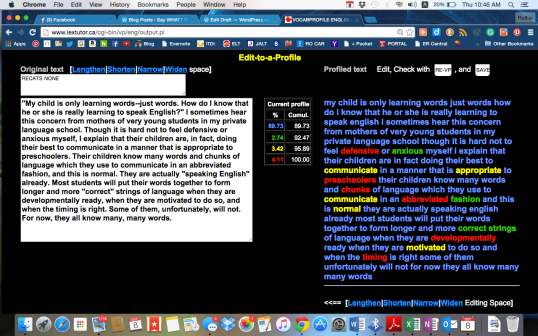Getting Intimate with Words (Class five)
“My child is only learning words–just words. How do I know that he or she is really learning to speak English?” I sometimes hear this concern from mothers of very young students in my private language school. Though it is hard not to feel defensive or anxious myself, I explain that their children are, in fact, doing their best to communicate in a manner that is appropriate to preschoolers. Their children know many words and chunks of language which they use to communicate in an abbreviated fashion, and this is normal. They are actually “speaking English” already. Most students will put their words together to form longer and more “correct” strings of language when they are developmentally ready, when they are motivated to do so, and when the timing is right. Some of them, unfortunately, will not. For now, they all know many, many words.
I am always patient and reassuring when dealing with parents, but sometimes what I really want to say is, “What do you mean, JUST WORDS?” Knowing words is a very big deal, and not just for me personally. In the field of linguistics, scholars have devoted their lives to and built their reputations on vocabulary acquisition research. Chapter eight of the Ear book contains a whole section on vocabulary and how absolutely essential it is for listening comprehension, so that will be the topic of today’s blog post: how knowing a word intimately can make you a better listener.
Let’s begin by considering the quantitative aspect of vocabulary acquisition: corpus linguistics studies show that to understand an everyday conversation, we need to know at least 3,000 word families. But on the other hand, and this is the most interesting part for TESOL students, there is the qualitative aspect: how deeply do you know those same words? This is called depth of vocabulary knowledge, and it affects the saliency of words in our mind ( obviously, the deeper we know a word, the better it sticks ) and our ability to use them appropriately in their correct context ( pragmatics again ).
Let’s talk about knowing a word intimately. First, you need to recognize it when you hear it ( my four year old pre-readers are at this stage ). Some would even argue that true aural recognition would include hearing the word spoken in a variety of different accents. And then there is the problem of recognizing the same word as part of a spoken phrase, since issues like segmentation ( word boundaries ) and elision ( the omission of sounds ) come into play, adding to the learner’s already heavy cognitive load. A word may have an unfamiliar contracted version ( for instance “until” and “till” ) as well. And–just to make things trickier–there are plenty of homonyms: words with the same pronunciation but bearing a different meaning. Serious learners had better be familiar with those, too, or who knows what misunderstandings might ensue.
Enough of the aural challenges of knowing a word–let’s move onto recognizing it visually. Is that really so important for listening? I know that it is for me; there are many Japanese words that I know only “by sound”, never having seen them in writing, and I cannot seem to consistently catch them in conversation. As my friends and fellow students will tell you, I am a visually oriented person, and without seeing a word in print, it simply is not salient enough for me. While some learners might be satisfied with only an aural level of “knowing”, learners like myself realize that knowing the spelling of a word and recognizing it swiftly in print gives them a more solid foundation. And so, the formal study of spelling is part of most second language learners’ agendas. Certainly those receiving formal classroom instruction cannot avoid it.
In order to appreciate the challenge that L2 learners face, let’s begin by considering the problem of spelling from the native speaker’s perspective. While many native English speakers are actually poor spellers, they usually recognize in print the same words they cannot spell in an essay. Those native speakers who read widely as children often instinctively know how many words are spelled, simply from the hours of time spent in contact with the written language. Most second language learners, however, with no instinct to rely on or exposure to English books in their childhood, must wade into the muddy waters of orthography. Just how muddy are the waters? Look at the top half of the print below, which shows five different spelling combinations representing the same sound.

L2 learners struggle not just to spell words, but to recognize them in print. Learning words with similar spelling patterns together is one way of tackling the subject.
And then there are the aforementioned homonyms– words that sound alike but have different meanings–which must be mastered by explicitly learning the different spellings. Programs like Spellcheck or Autocorrect won’t help a learner make the right choice, since both words are spelled correctly and programs can’t advise one as to appropriateness. Those learners who are unperturbed when phonics rules don’t apply often learn to spell high frequency words fairly painlessly, and seeing similarly spelled words together in groups does help for many students. But the bottom line is hard work. As my talented former teaching assistant Satomi once told me, “I never got a bad grade on a spelling test. I knew how to get an A: just do the work and learn the words, that’s all. Grammar was another matter!”
And speaking of grammar, knowing a word’s grammatical function is part of knowing that word deeply. Second language learners explicitly learn not just content words (nouns, verbs, adjectives and adverbs ) but the trickier function words ( those shorter bits of language that connect with content words to further clarify meaning ) as well. Along with this comes word order, which is instinctively recognized by native speakers, but often different from the L2 learner’s own mother tongue. In short, it’s an exhaustive and often frustrating process to formally learn grammar…..but the benefits are undeniable, and they greatly ease the listener’s mental processing of speech. Here’s how it works, in a nutshell: As the L2 learner listens, his or her brain busily constructs a rough grammatical framework ( as Rost explains it ) and fits the recognizable elements of speech into that framework, comparing them with semantic and morphological cues to establish meaning. In cases where precise understanding is necessary, the brain will actually sort through individual heard utterances, sorting them into appropriate categories, dividing content and function words and checking for things like word order and subject-verb agreement. Of course, not everyone who speaks a second language has formally studied its grammar, and from what we’ve learned in class in the past five months, this is often reflected in their speech which, although communicative and comprehensible, is often riddled with errors. The point is that part of knowing a word is knowing its grammatical function, which allows us to both use the word correctly in speech and to identify and process it swiftly when we hear it.
And then there are collocations! What words frequently occur in combination with the target word, and is the second language learner able to recognize the same word when it’s embedded in chunk of language? Take the word “take”, which is my favorite example. Literally, according to the Oxford Dictionary of English, the most common meaning is “to lay hold of (something ) with one’s hands”. And then the fun starts, as students learn the million-and-one collocations that have nothing to do with the laying on of hands: take a bath, take a bus, take a test, take a trip, take a nap, take your time, take it easy, take a hike!, take care, take off, take in, take out, etc. etc. I was tempted to write “as students struggle to learn,” but actually, collocations don’t have to be a struggle. Of course, you can still buy serious books featuring exhaustive lists of collocations and idioms ( my Japanese husband bought plenty in his quest to master the English language ), but the world of online learning has other engaging and relevant resources for students who are motivated to search and teachers who are motivated to experiment with them in class. Collocations are chunks, they have rhythm and meaning, and the more you use them, the more salient they become. Take a listen to my friend Jase Levine ( a.k.a. Fluency MC ) who has literally made a career out of collocations. Students around the world find his chants highly motivating and just plain fun. It’s learning, Krashen-style: relax, enjoy, and acquire, rather than sweat and memorize.
So what else is there to knowing a word intimately? Learners should be aware of a word’s frequency in usage, especially in Asian countries where exam systems require students to memorize scores of very low-frequency academic words at the expense of “easier” but very high frequency ( i.e. commonly used ) words. Unless a learner has a specific need for difficult and rarely used vocabulary, they are better off spending their energy with the most frequently used words that will allow them to function communicatively outside of their own language community. Language students can now plug words into a corpus analysis tool and immediately see their frequency as well as their family and collocates. Like Fluency MC and his collo videos, corpus analysis tools are fun ( you’ll be mesmerized once you figure out how they work ) and useful, both for second language learners and native speakers as well. Here’s a screenshot of a lexical analysis of the first paragraph of this blog post.
The words in blue are all high frequency, found on the 1,000 most frequently used ( written, not spoken ) words list. Those in red occur so infrequently they are considered “off-list” words. Sometimes the results of an analysis can be surprising: apparently no-one writes about preschoolers? Maybe they write about pre-schoolers. : ) And no-one writes about “chunks”? No-one writes about timing? At any rate ( and most importantly ), this particular analysis shows that the words I’ve used in my blog are 89.7 % high frequency words, meaning that this post should be accessable to the average Joe, or even to a diligent second language student. I hope so. Analysis of spoken language is a still different matter, and even more relevant to the process of listening. Read about the compilation of a corpus of 100 million spoken words and its ongoing analysis here–it’s good stuff.
Let’s recap: to know a word intimately involves recognizing it aurally ( catching it in speech, in spite of accent or phonological variations ) and visually ( being able to read it automatically in spite of its seemingly irrational spelling ), knowing it’s syntactic function, its collocates, and the frequency of its use in both written or spoken language. There are also synonyms and antonyms, denotations and connotations ( slim has a more positive connotation than skinny, for instance ), and pragmatic restrictions. Many years ago, I remember our family wincing when my host sister Anja from Germany said matter-of-factly, “Give me the butter”–a direct translation from German, and not meant to be rude, but certainly not an acceptable use of “give” in a dinnertime context. We taught her, “Pass the salt, please,” laughed about it together, and she learned fast. All these aspects of vocabulary combine to form recognition vocabulary: words that are firmly ensconsed in the learner’s mental lexicon and easily accessed and processed in real time listening.
So when students study a “word list”, remember the terms successfully, and score well on a test the next week, there’s a good chance that they haven’t learned the words at all. A post-test two weeks later would reveal that unless those words were used after the test in class, frequently and in a variety of meaningful ways, students would not be able to duplicate their former stellar scores. And even if they could, choosing correctly on a test shows that students recognize a word as it is used in that specific instance, not necessarily in other ( i.e. spontaneous communicative ) situations. Needless to say, because the word would not yet be salient enough, students might not recognize it in speech, either, no matter how clear their native teacher’s pronunciation might be. Got the point? Knowing a word intimately is no easy task, but discovering words in depth, rather than breadth, is also infinitely more rewarding than memorizing definitions.
You think your child is learning “just words” then? Think again. They’re building the framework for a house that will hopefully last a lifetime. Stop worrying! Either lend a hand in the construction, or step out of the way and let them get to it.




